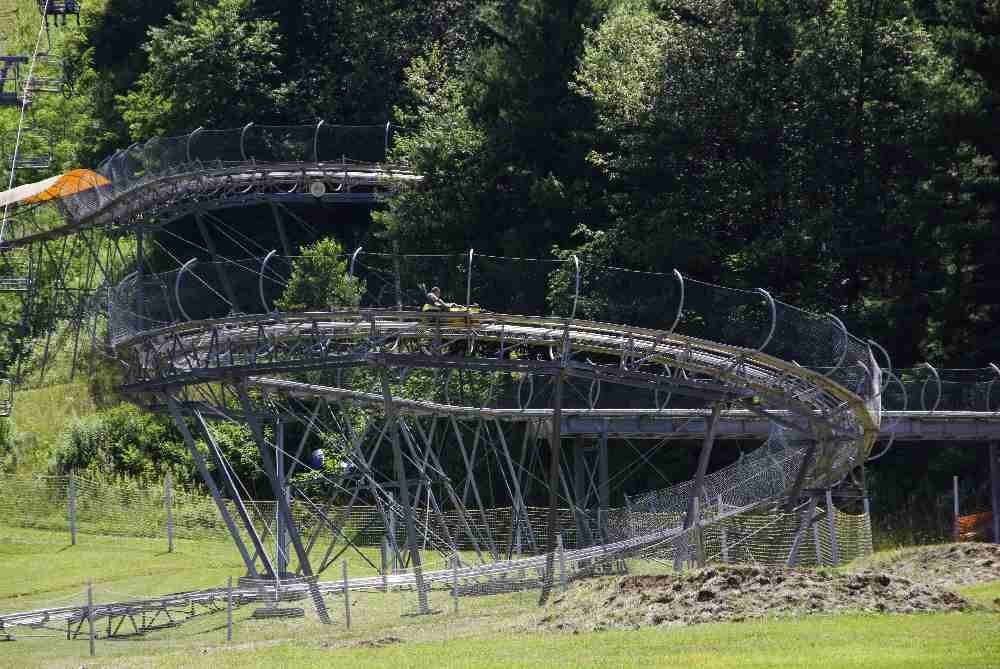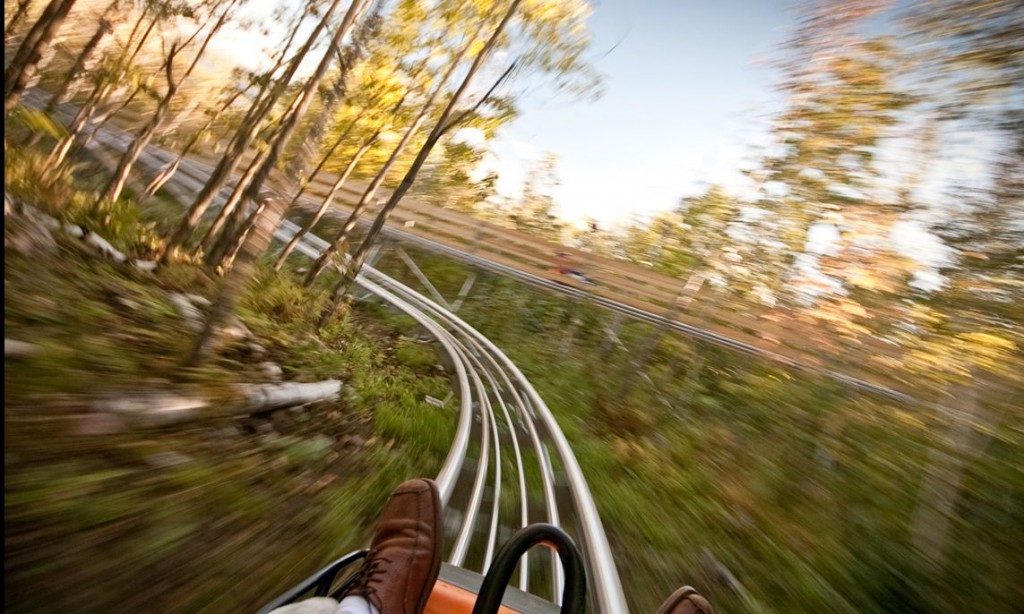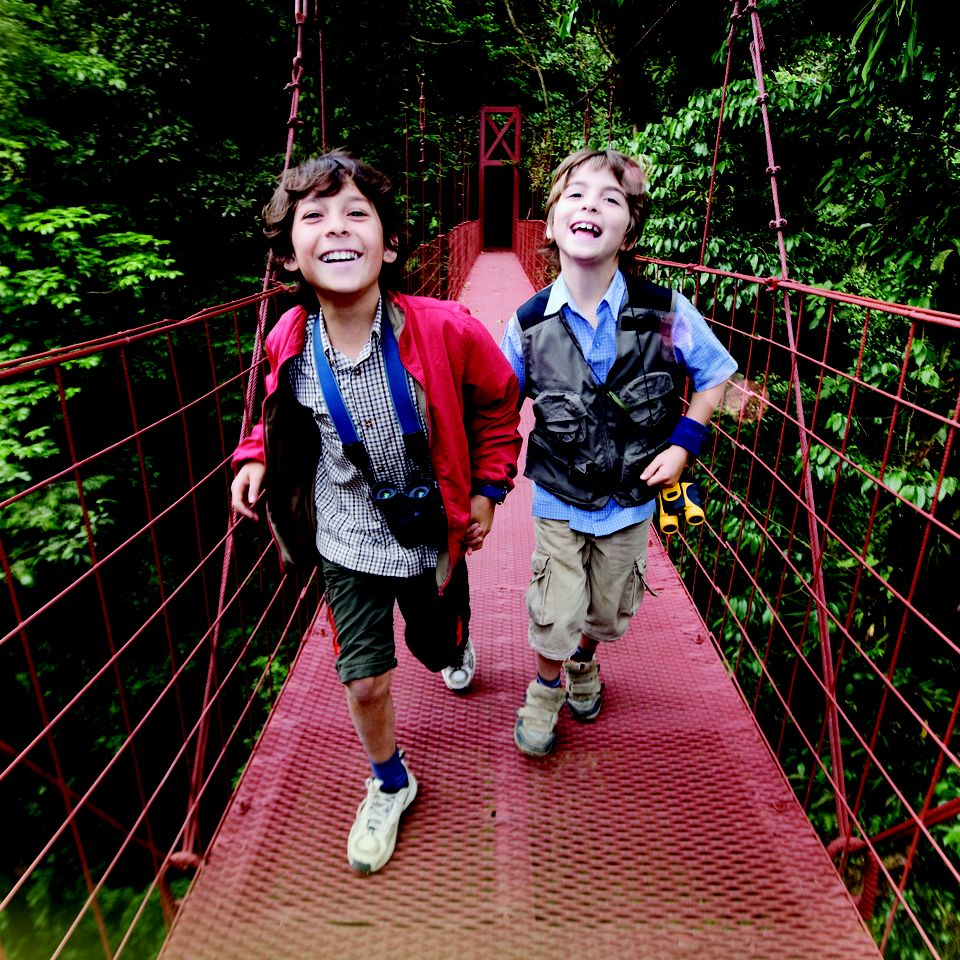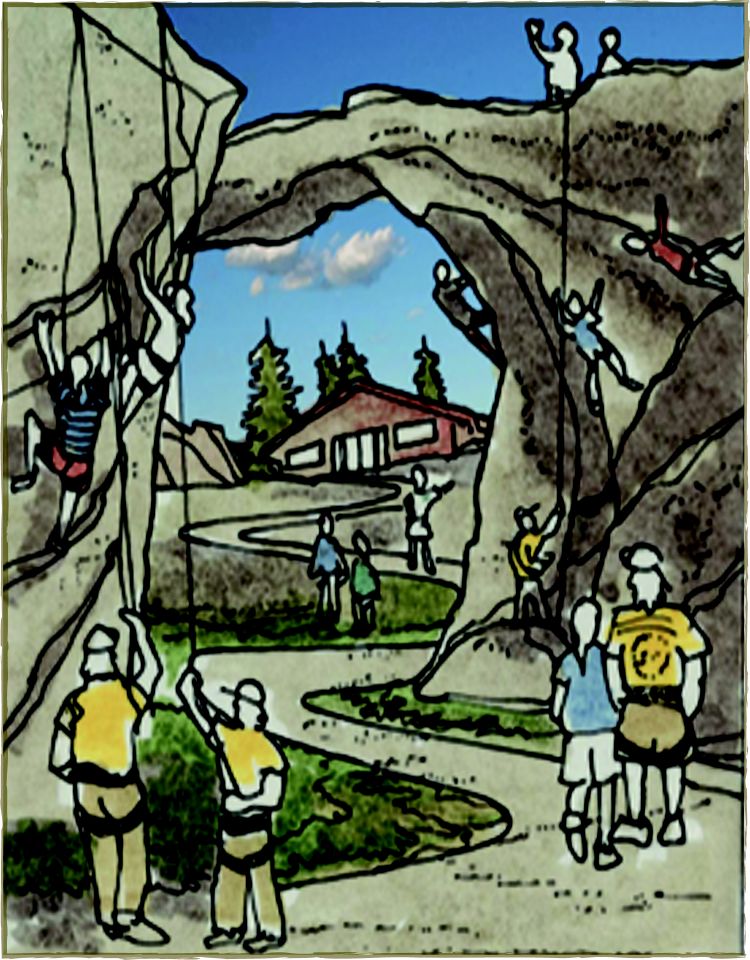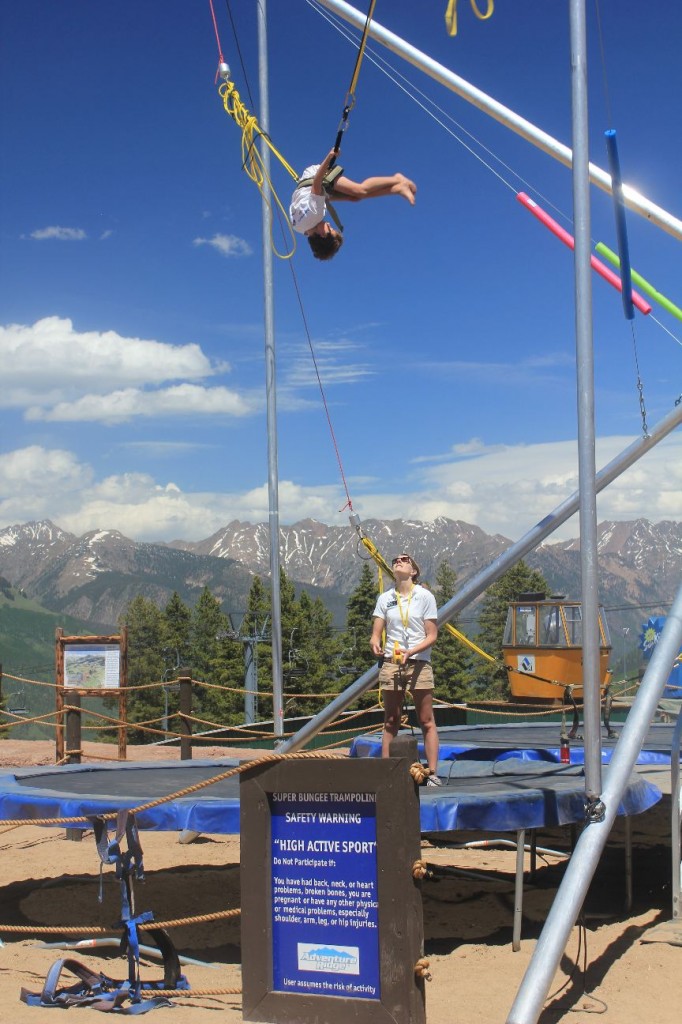
Overpromoted boss failed to connect with club’s romantic spirit
April 22, 2014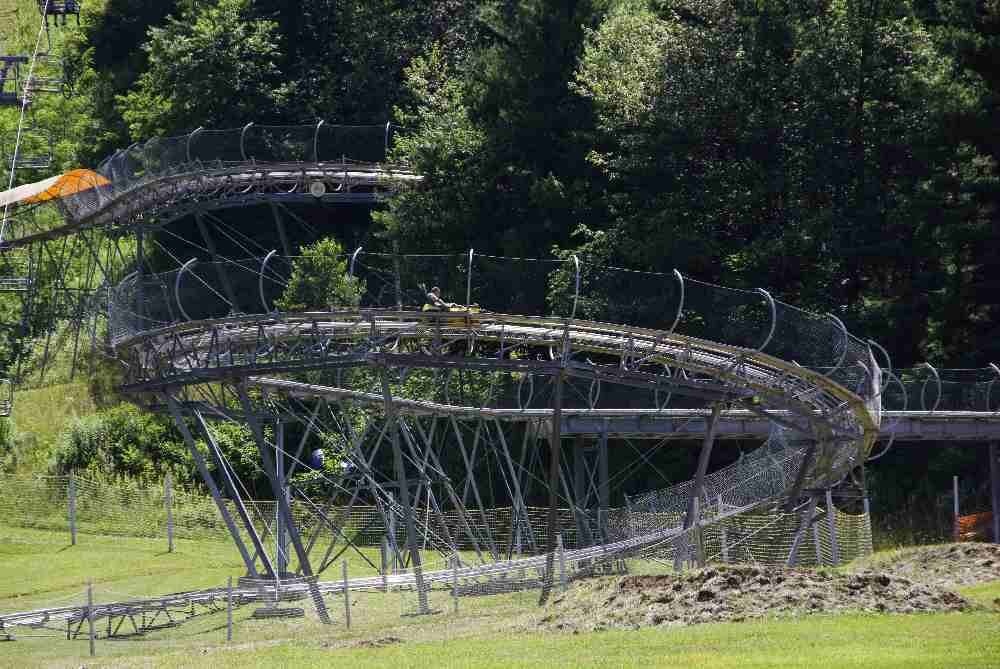
Summer use of ski areas
April 22, 2014Alpine coasters are common in Europe, which is the setting for this coaster, but are entirely absent at ski areas in the United States located on federal lands.
Vail Mountain the test case for federal authority allowing expanded summer activities
by Allen Best
Oddly, given the motivations for its adoption, the Ski Area Recreation Opportunity Act makes no mention of alpine coasters.
Signed by President Barack Obama in late 2011, the law was intended by Congress to give the Forest Service broader authority to permit summer-time uses at ski areas.
Geraldine Link, director of public policy for the National Ski Areas Association, traces the conversation to 1998 but points to two more recent triggers, both in Colorado.
Winter Park wanted to build mountain bike trails but was challenged by environmental groups, who cited the lack of legislative authority. Vail Resorts wanted to build an alpine coaster on Vail Mountain, such as has existed on the privately owned lands of Park City Mountain Resort.
The 1985 federal law governing use of national forests by ski areas was silent on summer uses. Without clear direction, local offices of the U.S. Forest Service allowed some uses, 20 altogether, but not others.
NSAA lobbied for the change, and Mark Udall, then a U.S. representative whose district included both Winter Park and Vail, agreed to sponsor it. The Forest Service supported the revision.
Unacceptable, as specified by the law, are water parks and swimming pools, tennis courts and amusement parks.
Specifically authorized are ziplines, mountain bike parks, Frisbee golf courses, and ropes courses.
Nowhere is there mention of the alpine coaster that motivated Vail’s push for change.
ForestFlyer, as Vail Resorts calls its alpine coaster, will huge the ground more than is found in some other locations.
Vail prefers to call its device a ForestFlyer®, a name that is trademarked, and is careful to distinguish it from a roller coaster, such as is found at amusement parks. At Park City, however, which has had an alpine coaster since 2004, managers see little difference between the two, at least in technology. The major difference is that alpine coasters mostly hug the ground, like the alpine slides that have existed on private land for decades. Roller coasters, of course, have elevated courses. But as you can see on this YouTube video from Kaprun, Austria, the distinction is blurred. http://www.youtube.com/watch?v=su39eM7xsoE
The Forest Service, in drawing up final implementing regulations, could mention an alpine coaster, but Jim Bedwell of the U.S. Forest Service doesn’t expect they will.
“It’s just very difficult to definitively define many of these things,” says Bedwell, who directs recreation and heritage resources for the agency from its Lakewood, Colo., offices. “There’s always something new under the sun.”
In a memo sent to NSAA members this week, Link said that that mountain coasters are to be considered on a case by case basis. “in fact, she reports, ” anything not listed in the statute as allowed (such as climbing walls, geo-caching, alpine slides, mountain coasters) or prohibited are all to be approved on a case-by-case basis to allow for flexibility to address changes in activities.”
Not the holy grail
With this new authority, Vail has become the test case for what is acceptable. Last year, it unveiled its plans for first Vail Mountain and then Breckenridge, with similar plans for Heavenly.
Much is in store at those three resorts, but Vail Resorts has no illusion that this constitutes the ski industry’s Holy Grail, the warm-weather equivalent to downhill sliding.
“Winter revenues are dramatically greater for our company, and they always will be,” declares Blaise Carrig, the president of the company’s mountain division.
Vail believes these new summer attractions can smooth the bumpy annual cash flow while also delivering ancillary benefits, such as being able to offer more year-round jobs.
“What we are hoping for is that we can grow our summer business to significantly reduce or eliminate the loss quarters (of summer and fall),” says Carrig.
At Vail, Breckenridge, and Heavenly, the three mountains where the company plans a full complement of summer activities under the banner of Epic Discovery, Vail Resorts thinks it can triple summer attendance.
On Vail Mountain, the company has already started building ziplines and other activities in what is expected to be a $20 million to $25 million investment spread across three to four years. Parallel investments are budgeted for Breckenridge and Heavenly. The company projects annual summer revenues of $15 million at each of the resorts.
While Vail has some new twists, the activities at least partly follow those previously adopted on private land at both Park City and Whitefish
Image/Vail Resorts
Lesser investments involving one, two, or three activities are planned at Beaver Creek, Keystone, and Northstar, which lack the critical mass of summer visitors to justify additional investment. Too, while the larger resorts may have multiple ziplines or rope courses, just one may suffice at each of these secondary resorts.
Vail plans a hierarchy of uses from simple hikes to more daring adventures: ziplines and rope courses, canopy tours, and climbing walls.
The company plans to expand its mountain bike trails, too, although nothing of the sort found at Whistler’s Crankworx.
VRI’s Carrig also describes a spectrum of users, perhaps even more divergent in skill levels and athleticism than found on ski slopes. “There are definite ability levels, perhaps even more dramatic in summer than in winter. We will have people who are novices, new to the mountains, and sightseers. We will have people who are a little more active. We call those discoverers, capable and willing. And then we will have those people who are truly very physical, very engaged adventure seekers,” says Carrig.
Activities are intended to be inclusive, accommodating a range of fitness levels, ages, and psychological temperaments. Three generations of a family should be able to participate together, if at different levels of difficulty.
For examples, ziplines are to be shorter to longer, lower to higher, slower to faster. The ropes course will similarly have increments: 10 to 15 feet off the ground and working up to the top increment, 30 to 40 feet above ground.
“We wanted to design a program that could be all things to all people,” says Carrig.
Time of activities will run the gamut from 10 or 15 minutes to three hours for a full canopy tour.
Studying Disney, the Alps
In studying what activities to include, Vail Resorts sent representatives to the Alps and to Disneyland. Delegates in both places were most interested in how the resorts engaged customers during and between activities. This ties to Vail’s aspirations to use the outdoor setting for something deeper and richer. At a meeting in Vail last summer, chief executive Rob Katz even proclaimed that the company would create “the largest children’s interpretive museum in the world.”
Carrig amends that only to include adults. He describes the fundamental challenge as being “how do you make learning fun and interesting in these types of settings?” Indoor museums have had the same challenge. They no longer just put stuff behind glass cases. More and more, they figure out ways for people to learn while being actively engaged.
What a climbing wall might look like at Vail Mountain. Image/Vail Resorts
Ally Dodge, vice president of marketing, explains that the educational component will be carefully woven into the experiences. For example, on a zipline tour, customers might learn how fast they are going and what else in nature goes 60 mph. Or the aerodynamics of a hawk might be explained and compared with those of a zipline rider. In canopy tours, participants might learn about the height of the trees, the deepness (or shallowness) of the roots, how the aspect of the slope affects tree growth, and so on.
“For every piece, there will be this new ‘ah-ha,’ something you had never considered before,” she says.
But unlike some museums, there will be almost no extraneous equipment. “We are not bringing in foreign objects. We don’t have to build a tree. We have a tree,” she says.
The engagement themes for the resorts will differ. Vail’s educational component will focus on the nearby Gore Range, Mount of the Holy Cross, and the Sawatch Range. At Breckenridge, engagement will more strongly relate to its history, including the gold-mining that began in 1859. Heavenly’s engagement will slant to the wonders of Lake Tahoe that Samuel Clemens observed as a young vagabond in the 1860s.
In addition, Vail Resorts plans view decks, somewhat similar to those in national parks. In Jasper National Park, for example concessionaire Brewster Travel last year opened what is called the “Glacier Skywalk,” a glass-bottomed viewing platform cantilevered 30 meters away from a cliff face and 280 meters over the canyon floor. A similar transparent horseshoe-shaped cantilevered skywalk at Grand Canyon National Park has 500 to 800 feet of direct exposure to rocks below and allows an unrestrained view of the Colorado River 4,000 feet below.
At its ski mountains, Vail does not have the same precipices, but the goal will be to give people a greater sense of the mountain grandeur.
Vail Resorts seeks to strike a middle course. Activities will not be dispersed completely across the ski mountains. At Vail Mountain, activities will be congregated at Adventure Ridge, the existing complex at the top of its gondola from Lionshead, but then spread out from there so that customers have a greater sense of isolation.
With only minor exceptions, such as small buildings, Vail plans no additional infrastructure. “It’s about using our existing infrastructure better,” says Carrig. “We are not proposing any new buildings or lifts to support this. We are designing these programs to work around our existing core infrastructure.”
More diverse customer base
Who will be the customers? Vail Resorts sees somewhat different demographics for its summer customers than those of winter. Certainly, some of the winter destination guests will be drawn to the summer activities, as will winter customers from nearby cities.
But summer activities will be more accessible to a diversity of income levels, physical abilities, and ethnicities. For example, while Latinos comprise 21 percent of Colorado’s population, Vail and Breckenridge draw relatively few Latino skiers. In summer, that proportion might grow.
Too, unlike skiing, which is almost never a spur-of-the-moment decision, the resorts expect to draw more people driving by on nearby I-70 or, in the case of Heavenly, those visiting Lake Tahoe or the casinos of Nevada.
“You don’t need to come with skis, boots, and poles,” says Carrig. “The cost points are going to be lower than skiing. Some of the market is going to be much bigger than winter, and the diversity of the market will be much greater, which I think is very exciting to have the opportunity to introduce different demographics to the mountains.”
Vail Mountain has had a variety of activities at its Adventure Ridge location and last year added zip lines. Photo/Allen Best
Activities can be purchased a la carte, although eventually there will be an all-activity pass. Prices have not been determined.
Marketing strategies also haven’t been determined, but Vail envisions a much broader marketing effort in terms of to whom it will market, where, and how. “I have some time to put some thought into it,” says Dodge.
Other ski area operators have also been exploring how to take advantage of this new authority, although very few were willing to share their thoughts for this article. Steamboat and Winter Park, for example, did not respond to interview requests.
NSAA’s Geraldine Link sees increments at ski resorts. “Ropes courses, ziplines, mountain bike trails, or parks and features will be the most common. And the larger resorts will take on multiple projects at once, while smaller resorts might just start with one or two,” she says.
For more on Vail’s Epic Discovery program, see: http://www.epicdiscovery.com/vail/
Also, Park City Mountain Resort began summer attractions in early 2000s
Whitefish Mountain Resort also has been flying high.
And Jackson Hole’s Snow King Resort hopes to also augment summer.

